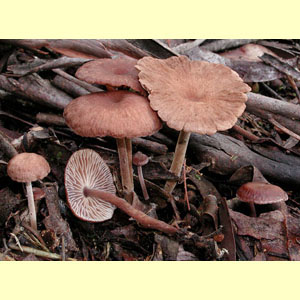
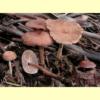
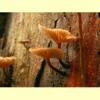
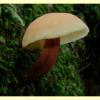
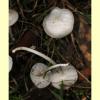
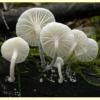
The following species are currently placed under Collybia, Marasmiellus or Micromphale but they probably belong in Gymnopus: Collybia endota, C. eucalyptorum, C. kurara, C. nijerria and C. pinacolens; Marasmiellus candidus, M. delicus, M. kindyerracola and M. rawakensis; and Micromphale australiensis, M. miramirildinum and M. rugosum.
A number of species currently in Collybia (C. alutacea, C. moola, C. percava, C. subdryophila and C. yerilla), which mostly lack cheilocystidia (or else they are unbranched), are not disposed to either Gymnopus or Rhodocollybia due to the absence of information on diagnostic characters.
Marasmiellus affixus (pleurotoid, with a strong odour) is keyed out separately.
Fuhrer, B. (2005), A Field Guide to Australian Fungi. Bloomings Books, Hawthorn. [Description and Illustration of G. dryophilus (as Collybia), Marasmiellus candidus, Marasmiellus foetidus and Collybia eucalyptorum]
Grgurinovic, C.A. (1997a), Larger Fungi of South Australia. The Botanic Gardens of Adelaide and State Herbarium and The Flora and Fauna of South Australia Handbooks Committee, Adelaide. [Description and Microcharacters of G. villosipes, Collybia endota, C. eucalyptorum, C. kurara, C. nijerria (also Illustration), C. pinacolens, Marasmiellus kindyerracola, Micromphale australiensis, M. miramirildinum and M. rugosum, and see Key to South Australian species of Collybia and Micromphale]
McCann, I.R. (2003), Australian Fungi Illustrated. Macdown Productions, Vermont. [Illustration of Collybia eucalyptorum, and also of several unnamed Collybia and Marasmiellus species that also quite possibly belong Gymnopus]
Pegler, D.N. (1986), Agaric flora of Sri Lanka, Kew Bull., Addit. Ser. 12: 1–519. [Description, B&W Illustration and Microcharacters of Marasmiellus delicus and 16 other species of Marasmiellus along with Key]
Pegler, D.N. & Young, T.W.K. (1989), The genus Anthracophyllum (Tricholomataceae Tribe Collybieae), Mycol. Res. 93: 352–362. [Description, B&W Illustration and Microcharacters of Marasmiellus rawakensis]
Singer, R. (1973), The genera Marasmiellus, Crepidotus and Simocybe in the Neotropics, Beih. Nova Hedwigia 44: 1–517. [Description and Microcharacters and some B&W Illustrations of numerous species of Marasmiellus and Key]
Wilson, A.W., Desjardin, D.E. & Horak, E. (2004), Agaricales of Indonesia. 5. The genus Gymnopus from Java and Bali, Sydowia 56: 137–210. [Key, Description, B&W Illustration and Microcharacters of 24 species of Gymnopus from Indonesia]
